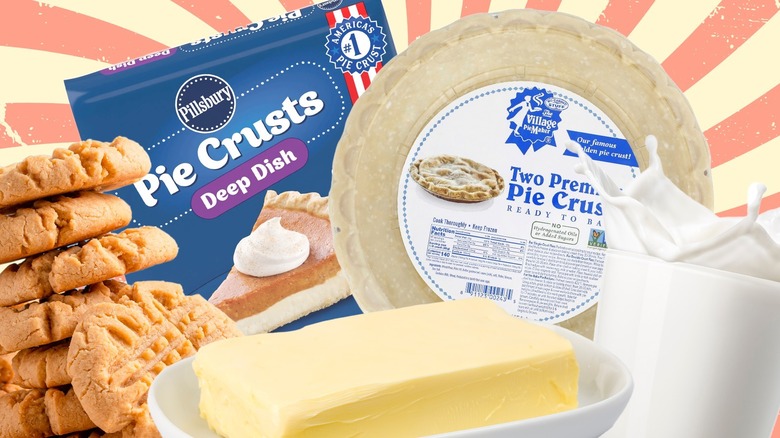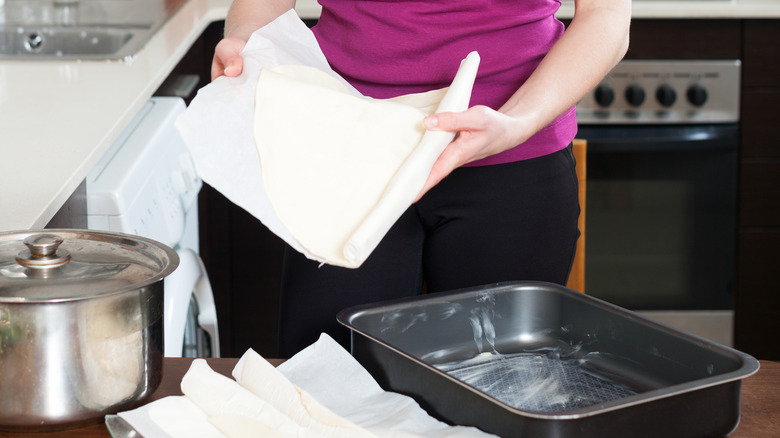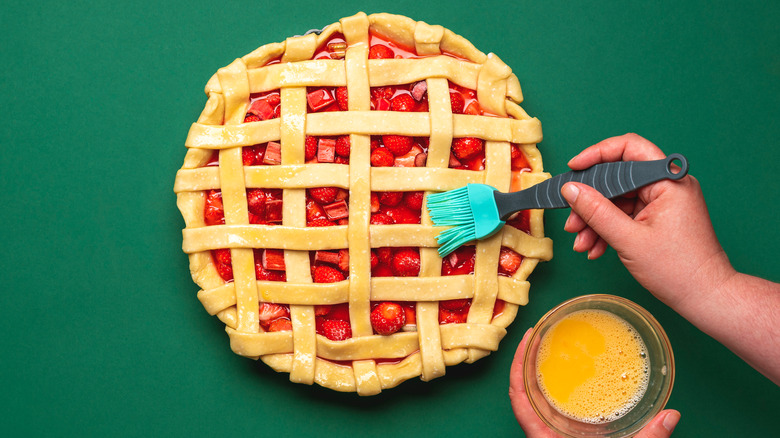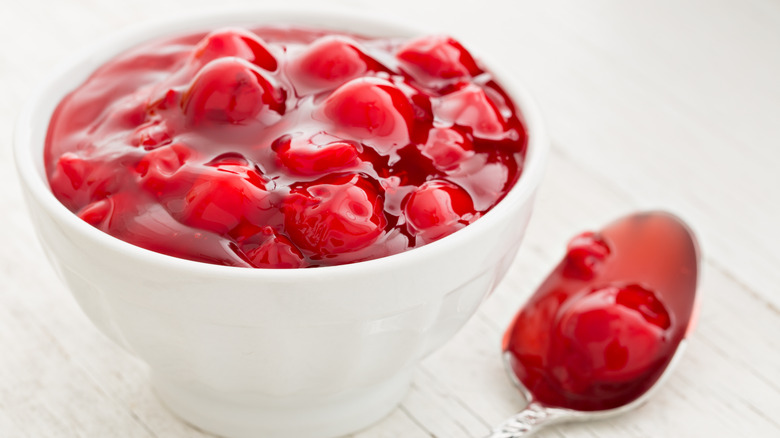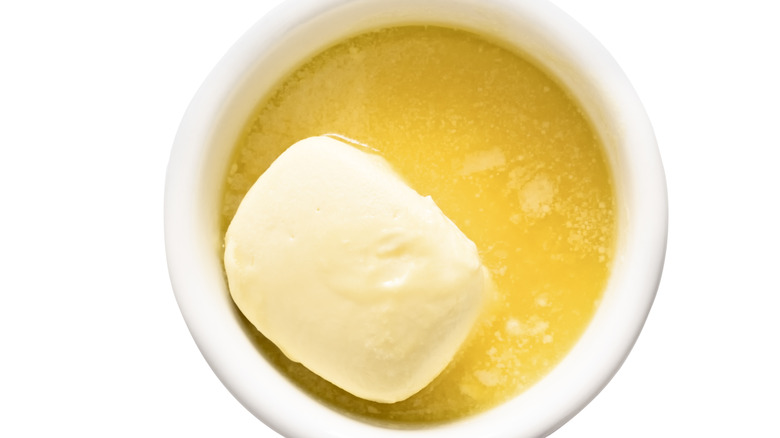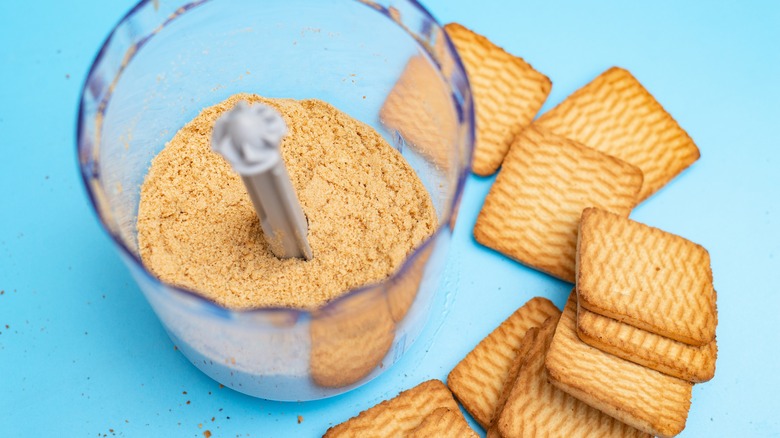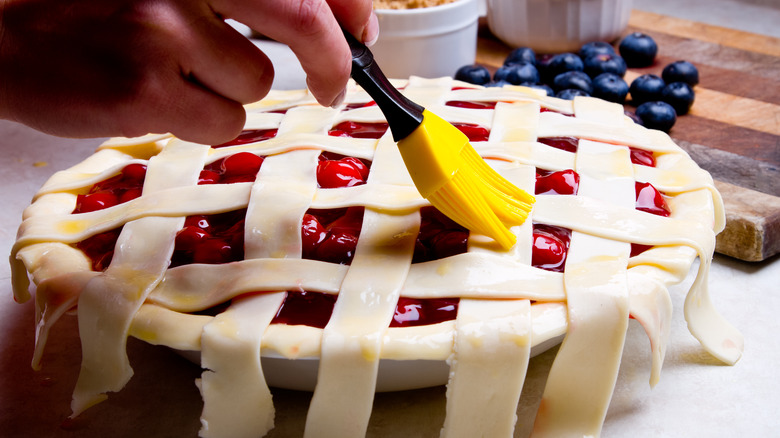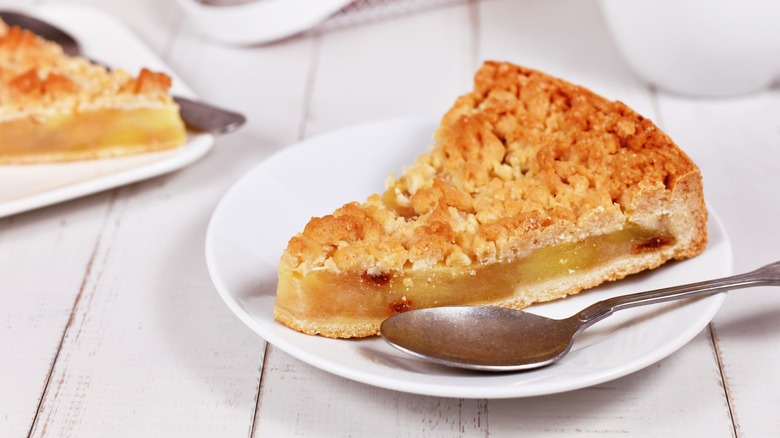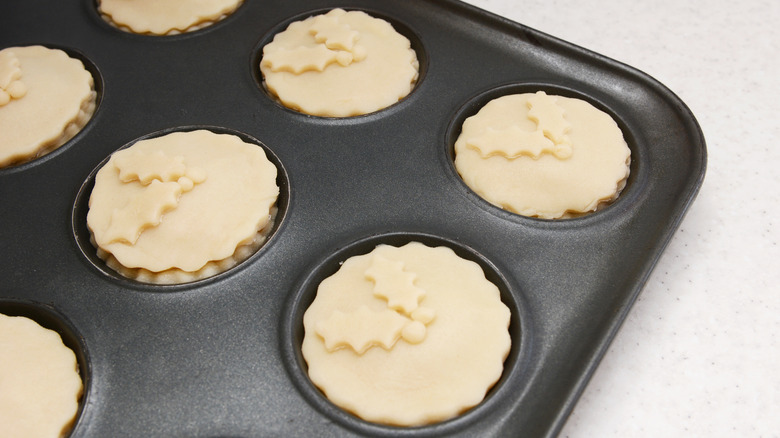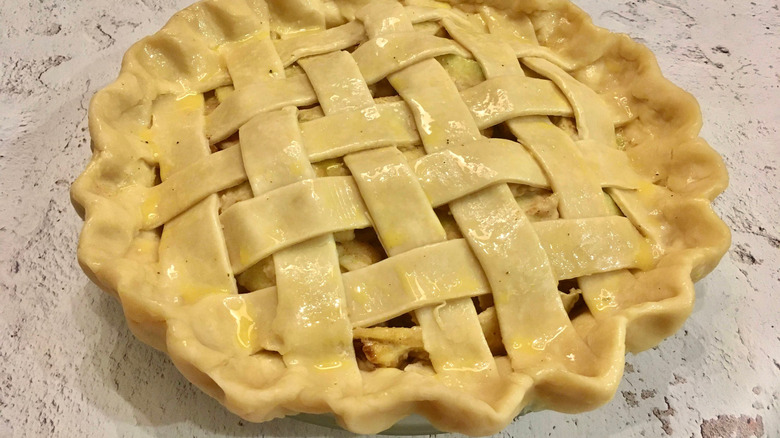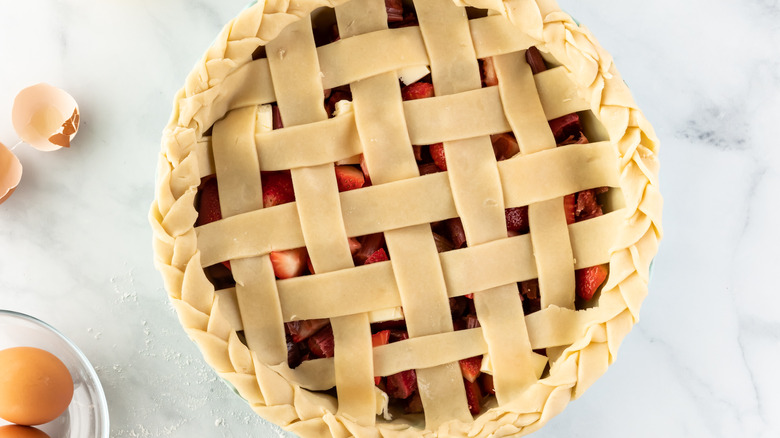11 Ways To Upgrade Store-Bought Pie Crust Like A Pastry Pro
There's nothing quite like a homemade pie, but finding the time to make pastry dough from scratch isn't always an option. Not to mention that there's skill involved, so newbies to the pie making game might not want to risk messing up the pastry, especially when making dessert for an occasion. Luckily, you can upgrade store-bought pie crust, turning it from dry and flavorless into something people might mistake for homemade.
As a food writer and obsessive cook who's worked in professional kitchens, I've made plenty of pies in my time. However, I wanted to get the lowdown from people with even more experience, so I spoke to a professional pastry chef, a trained pastry chef turned food blogger, and a head chef with training in baking and pastry. This is how I learned ways to upgrade store-bought pie crust like a pastry pro — and I'm about to share them with you.
"We all start somewhere," Back 40 pastry chef Caitlin Bussard reassures us. "That said, I think once you learn a great pie dough recipe and gain the confidence to make it yourself, you'll never go back." So, stick with upgrading store-bought pie crust for now, but there are some super easy pie crust recipes you can try to get started, if you want to make your own down the line.
Use chilled or frozen pastry rather than a premade crust
When you think of store-bought pie crust, you might be picturing the premade crusts that come in a little foil pan, already baked. This is one option, but another is store-bought pastry from the freezer or the chiller. The experts I spoke to generally agreed that chilled and frozen pastry is better than pre-baked shells.
"I always choose frozen or chilled pastry over a premade pie crust," says Amy Hand, trained pastry chef and recipe developer at The Skillful Cook. "It gives you more freedom to choose the thickness of pastry and the cooked results are just better, especially when you choose pastry made with real butter," she adds.
Ana Torrealba is the chef de cuisine at El Naranjo in Austin, Texas with an Associate's Degree in Baking and Pastry from The Culinary Institute of America. She agrees that chilled or frozen pastry is the way to go. "It offers more versatility compared to prebaked pies, which can only be used in limited ways," she remarks. "Frozen dough allows for a wider variety of uses and can be enhanced." Like Hand, she recommends looking for dough made with butter instead of shortening for better flavor.
This simple switch can be a real upgrade to your finished pie over using a premade crust and it's hardly any extra effort. Sometimes you have to roll it out, but it often comes in ready-rolled sheets, so you just cut it to size.
Brush it with milk or egg
If you're throwing your pie in the oven without any kind of wash to the pastry, a simple way to upgrade it is brushing it with milk or egg. "You should always brush your pastry with a milk or egg wash before you bake it," notes food blogger and trained pastry chef Amy Hand. "This will give your pastry a shiny, golden finish, which looks just like homemade pastry."
Brushing with just milk or egg won't add a whole lot to the flavor, but it does greatly improve the finish of the pie, especially if you top it with a lid. Without an egg or milk wash, pie crusts can end up looking sickly and anemic. Those with a simple wash more easily achieve that deep golden finish that you want from a pie. So, even if the crust doesn't taste as good as homemade, it'll still look the part and that's something.
Let's not forget that some grocery store pie crusts are better than others. Even if you don't end up adding much flavor through your egg or milk wash, choosing a quality store-bought crust will make all the difference to how the finished pie tastes. What's more, if you go down the milk wash route, you could make it taste better by using flavored milk, like vanilla milk or strawberry milk.
Sprinkle on spices
If you want an upgrade that will bring some serious flavor to your pie dough, adding spices is a good call. It's an easy option because you probably already have a range of spices in your kitchen. Naturally, we're not talking about cumin or chili powder, but rather sweet spices, such as cinnamon, cardamom, or ginger.
"You can season a pastry the same as you can season anything else," remarks pastry chef Caitlin Bussard. "Something really underutilized is mace and makes an amazing addition to apple or pumpkin." It's a good idea to think about the spices and how they'll work with your pie filling. Bussard mentions pairing apple and pumpkin pie with mace — and these are two pie flavors that work well with basically any combination of sweet spices. Cinnamon and cardamom pair nicely with chocolate fillings, even if you might not think so at first. Ginger works well with rhubarb, bringing a brightness to complement the tartness. Berries are a little trickier, but cloves and nutmeg work with strawberries and raspberries, for starters.
If you're using ready-made dough that needs to be rolled out, you can sprinkle the spices on before you start rolling, to help mix them in with the crust. Ready-rolled pastry shouldn't be worked any further to keep it from getting tough, but you can lightly press spices onto it before filling. With premade pie crusts, just sprinkle spices on top and they'll mix with the filling.
Focus on the filling
Okay, so your store-bought pie crust isn't going to win prizes at the county fair, but you can still make a delicious pie. When you know the pastry isn't up to much, the best thing you can do is focus on the filling. For many, this is the star of the show, anyway, and a slightly lackluster crust doesn't make much difference.
"Premade pastry is hard to transform, so the main focus should be on the filling because that will elevate even the lowest quality store-bought pie crust," advises Amy Hand. "Whether you're making a fruit pie or something more indulgent like chocolate or peanut butter, you should always add a little salt to enhance the flavors," she says. Caitlin Bussard agrees that a little salt goes a long way to elevating pie fillings. Hand also believes that spices make all the difference in a pie filling.
But, of course, fillings are down to personal preference, so think about what you like and run with it. "I personally prefer fillings that are balanced between sweet, salty, and acidic flavors," says chef Ana Torrealba. Consistency is important, too. "For fruit pies, avoid overly runny fillings to prevent the crust from getting soggy," Torrealba adds. "You can add flour or cornstarch to the mix. If you're prebaking the pie, brushing some chocolate on the bottom can help prevent it from getting wet."
Add some melted butter
Pie crusts are better with butter. However, some are made with shortening and don't taste as good — that's why you should always read the label when buying pastry or pie crust. Either way, you can add some extra flavor to your dough by brushing it with melted butter. "You could brush it with butter and sprinkle sugar on top," suggests Ana Torrealba. "If you're using dough that isn't premolded, you can roll it out with sugar and brush it with butter before baking," she adds.
You could even brown your butter before brushing it onto your pie, giving it even more flavor. And, if you're wondering why you should use brown butter in your recipes, the gist of it is that it's delicious. So, get that butter in a pan on the stove and take its flavor to the next level.
But, butter isn't always an upgrade. "Melted butter or neutral oil works well to impart flavor, but can make things soggy if you use too much," notes Caitlin Bussard. So, add some butter but do it carefully and don't go overboard. It doesn't just have to be melted butter you add to your pastry, either. Torrealba suggests you "try laminating some soft butter into it for extra richness," if it comes chilled or frozen. She notes that this can help create flaky layers.
Use crushed cookies to bring more flavor
It might sound a bit out-there, but a simple way to add more flavor to pie crust is with crushed store-bought cookies. The idea is that cookie crumbs will help to lock in moisture so that the crust doesn't dry out during baking. This can be a particular issue with premade pie crusts that come already baked, as these have a tendency to be dry and crumbly. An added bonus: the cookie layer adds more flavor.
Want to try this out? Start with store-bought cookies. Buttery ones such as shortbread are ideal, but any work, as long as the flavor goes with your pie. The choice of flavor can really elevate things. For instance, spiced speculaas cookies are delicious in an apple pie. Then, crush the cookies into crumbs. The easiest way is to blitz them in a food processor, but you could also put them in a heavy freezer bag and crush them with a rolling pin. Take your crumbs and gently press them into your pie crust, then just fill and bake it as usual.
However, not everyone thinks this method is a sensible one. "What would work better if you wanted to go that route would be to crush hard cookies and add some melted butter to make your own crust," Caitlin Bussard remarks. "I usually do this if I'm making a quick cheesecake too." Other foods that you can transform into pie crust include crackers, cornflakes, and rolled oats.
Brush on a flavorful wash
Brushing a flavorful wash onto your pie crust is an easy way to upgrade it. Of course, a wash is best on a pie with a lid. So if you use a premade pie crust, you'll need to get some chilled or frozen store-bought pastry to use as a lid. Better yet, use the same chilled or frozen pastry for the base of the pie, too.
"I'm partial to an egg yolk mixed with a little buttermilk and a sprinkling of crunchy sugar or flake salt because I'm big about crunchy textures more than anything else," says Caitlin Bussard, pastry chef at Back 40. Ana Torrealba, chef de cuisine at El Naranjo, mentions brushing on butter and sugar, and adding spices.
If you're looking for a lightly boozy addition, a combination of melted butter, bourbon, and vanilla extract makes a tasty wash for pie crusts. Plus, you can adapt this depending on your preferences and what works with your pie filling. For instance, you could switch the bourbon for Irish cream liqueur or rum and swap the vanilla extract for coconut extract or almond extract. There are so many ingredients you could use in a wash to make your pie more flavorful. So, you might want to experiment and see what happens.
Make a streusel topping
Improving the rest of the pie can help level up a store-bought crust, so it's a good idea to think beyond the pie itself and focus on the extras that can make it extra special. And, who doesn't love a streusel topping? Adding one to the top of your pie filling, instead of crowning it with a pastry lid is a surefire way to get people thinking about how delicious your pie was, long after it has been eaten.
If you're wondering how to make a streusel topping, it's very simple. All you need is flour, sugar (preferably brown), and butter. Some people melt the butter and mix it into the flour and sugar, but another method is to cut or rub the butter into the flour, like you would if you were making shortbread or a fruit crumble.
A pinch of salt helps balance out the flavors and make your streusel even more delicious, but you can also flavor it with spices, such as cinnamon, nutmeg, and cloves. These kinds of flavors go especially well with pumpkin and apple pies, but work with many fruit pies. When your streusel is made, sprinkle it over the pie filling before baking, and put the whole thing in the oven until it's golden brown on top.
Get creative with the lid
An easy way to make a store-bought crust look better is to get creative with the lid. You'll need to make the lid from chilled or frozen pastry, even if you use a premade crust. Having a few methods under your belt will make your pie look better and maybe even taste better by association.
You might just want a classic round lid. To achieve this, cut the pastry dough into a circle slightly larger than the pie dish. Place it over the filled pie, trim the excess, and crimp the edges with a fork or by pinching with your fingers. Make sure to cut a few slits in the top to allow steam to escape. You can make a classic round lid look more special by cutting out shapes in a few spots with small cookie cutters. These could be seasonal, such as apples or leaves for a Thanksgiving pie or stars or Christmas trees for a festive pie. A variation on this is to use cookie cutters to cut shapes from a square of pastry and arrange the shapes on top of the filling, slightly overlapping them.
A lattice lid is another option. To make one, you'll first need to cut your pastry dough into even strips. Lay half of the strips horizontally over the pie. Weave the remaining strips vertically over and under the horizontal strips to create a lattice pattern. This method showcases the filling and lets steam escape naturally.
Crimp the edges
Another method for upgrading store bought pastry is to crimp the edges carefully. It won't do anything to the taste of the finished pie but it'll make it look more appealing — and maybe even pass for homemade. It's fine if your crimping skills are a little rustic, it'll just make it look more like you made the pastry yourself.
To crimp pastry, you'll need to cut it larger than your pie. There should be around a ¼ inch that sticks up beyond the edge of the pie plate. Use your thumb and forefinger to create a V shape on the outside edge of the crust, then use the forefinger of your other hand to press it into a gentle crimp. An alternative is the sunflower crimp for pie crusts. You use a similar technique but make a pointed edge to each crimp, like the petals of a sunflower.
Make a colored braid
Want to liven up a boring-looking pie crust? You can use chilled or frozen dough to make a colored braid to add around the edge of your pie. It's surprisingly easy to dye pie crust. You just work some gel food dye into the chilled pastry and it takes on the color nicely. You can split the dough into three before dying it, to color each piece a different hue. Or you can do a single-color braid. Alternatively, you could make a braid from undyed pastry dough.
Once your pastry is dyed (or not, if you want to keep it natural), roll it out and cut it into long, thin strips. Then, braid the pieces together, using a standard three-strand plaiting method. It needs to be long enough to wrap around the circumference of your pie. Once it's done, press it into the edge of the crust and bake as normal. You could use any leftover pieces of colored dough to cut out shapes or letters with cookie cutters to decorate the top of your pie.
